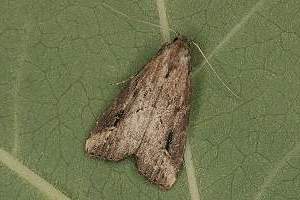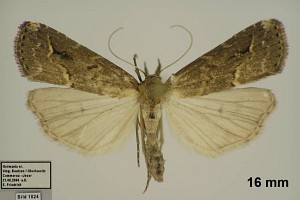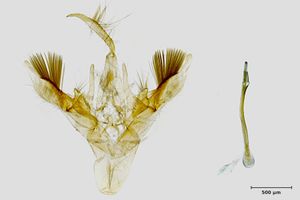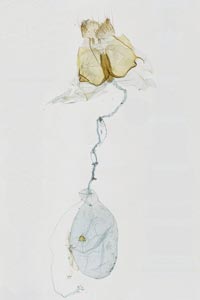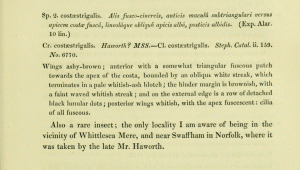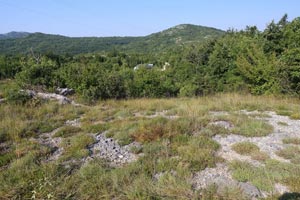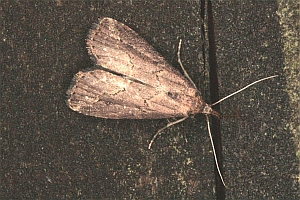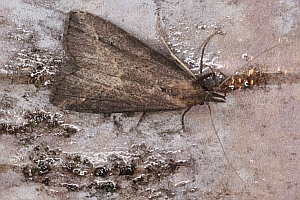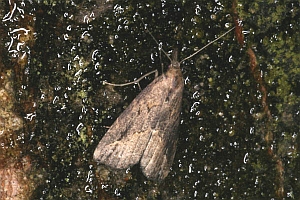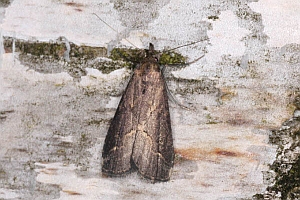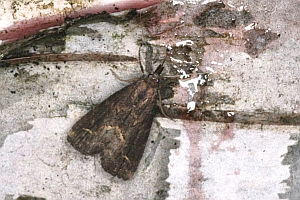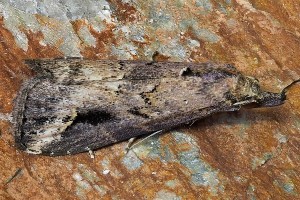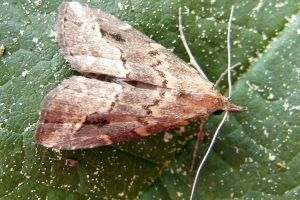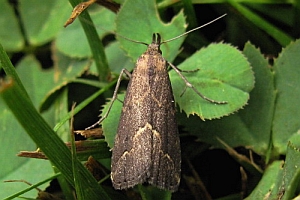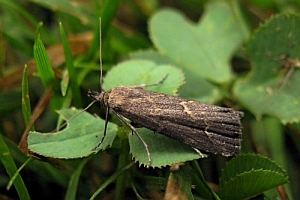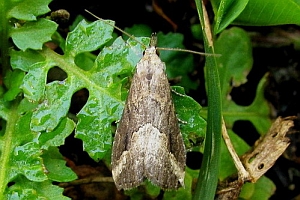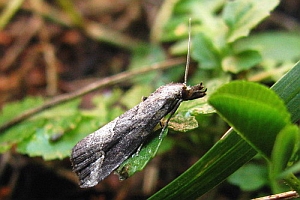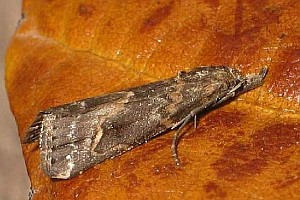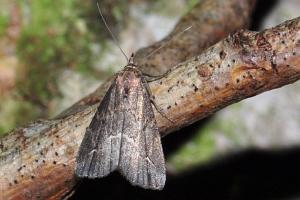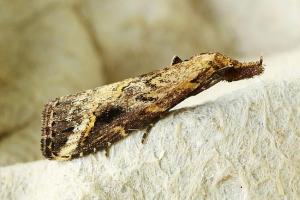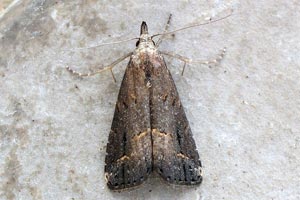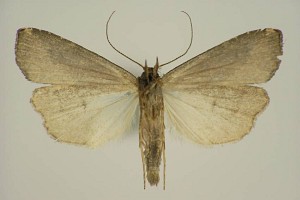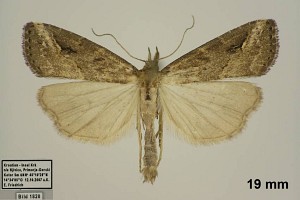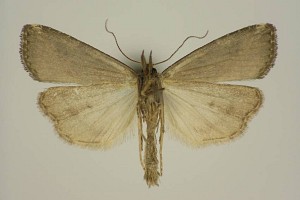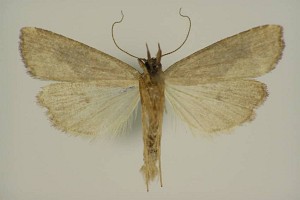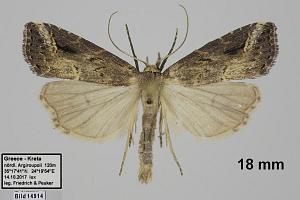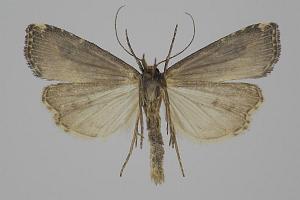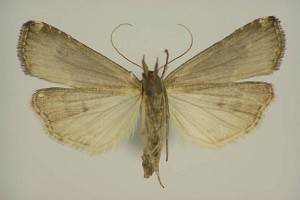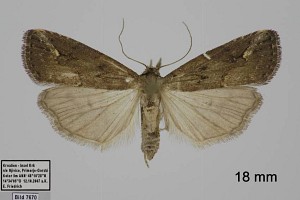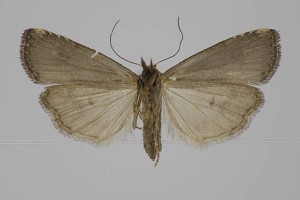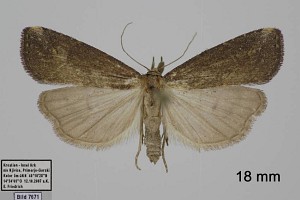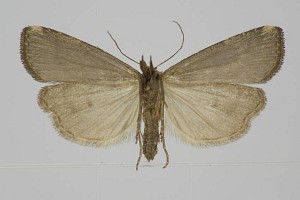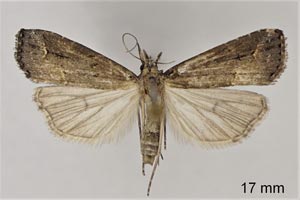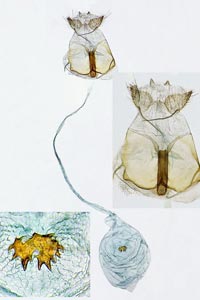

 +51Kontinente:EUASAFOC
+51Kontinente:EUASAFOC1. Lebendfotos
1.1. Falter
2. Diagnose
2.1. Männchen
2.2. Weibchen
2.3. Genitalien
2.3.1. Männchen
2.3.2. Weibchen
2.4. Erstbeschreibung
3. Biologie
3.1. Habitat
3.2. Nahrung der Raupe
- [Fabaceae:] Vicia faba (Saubohne)
- [Solanaceae:] Solanum tuberosum (Kartoffel)
Über die Nahrung der Raupe ist aus Europa fast nichts, aus dem Freiland gar nichts bekannt ! Schanowski et al. (1997: 420) notierten zunächst zu Baden-Württemberg: "Aus unserem Gebiet liegen keine Meldungen über die Raupennahrung vor." Da suchen sie in der Literatur: "n der Zucht nahmen die Raupen Thymian-Blüten an (Rössler 1881), Urbahn & Urbahn (1939) nennen Wachtelweizen, später noch Hohlzahn (Galeopsis) und Glockenblume (Campanula rapunculoides) (Urbahn 1968). Blütenblätter von Rose und Weidenröschen werden unter Hinweis auf Gewährsmann Vollmer von A. Gremminger (Kartei) angegeben. Bergmann (1954) nennt für Thüringen Thymus serpyllum und Calluna vulgaris, hiervon bevorzugt die Blüten. Allan (1949) fügt der Futterpflanzenliste aus Großbritannien noch die Blüten von Mentha aquatica hinzu." Und dann noch eine eigene Erfahrung: "Der Versuch, durch Eiablage erhaltene Räupchen mit (blühender) Calluna vulgaris zu züchten, schlug fehl: die Tiere nahmen diese Fütterungspflanze nicht an. (G. Ebert)."
Hier kann eine Meldung über Schäden an Vicia faba aus Japan von Yoshimatsu & Nishioka (1995: 546-547) etwas Klärung bringen: "The severe damage to broad bean, Vicia faba L. by Schrankia costaestrigalis was recognized in December, 1992 for the first time by the second author. However,the damaged areas were restricted to two districts of sothern part of Tanegashima Is. where plants on 149 a were damaged, According to the farmers of these areas, a similar phenomenon has been observed from 1990. Broad bean cultivation with vinyl-mulching was done from the end of September to March or April of next year. They rotate crops, i.e., after the broad bean, rice is cultivated from April to August. The larvae feed on the root and root nodule of Vicia faba L. and sometimes feed on the stems near the ground surface. The plants will die and fall down when the damage by the larvae was severe (Fig. 3). Such a damage is only seen in the plants which were cultivated on 3O cm diameter block of grey lowland soil and never seen in those cultivated on sandy field. [...] The larvae live between soil blocks, under O-15 cm deep soil, moving the underground spaces. It is easy to rear the larvae using soy bean sprouts (Fig. 5) and the larval period takes twelve days under 20°C-25°C by this method. Besides this way, it was successful to rear this larvae by adzuki bean sprouts, roots, root nodules, leaves, stems, pods and immature seeds of broad bean. Among them, the leaves of broad bean led the fastest growth of the larvae. However, it was not successfu1 to breed the larvae by perilla (Perilla frutescens Britt), white Dutch clover (Trifolium repens L.) and artificial diet for silkworm (SILKMATE-II)."
Und Zeng et al. (2020) berichten in ihrem Abstract aus China: „This paper presents the first report of the occurrence of the pinion-streaked snout Schrankia costaestrigalis (Stephens, 1834) in China and the first known record of this pest’s damage to potato (Solanum tuberosum L.) in the world. This discovery allowed us to alert entomologists and farmers, as well as agricultural agencies, and to provide a diagnostic tool to prevent potential establishment and spread of this newly introduced species in the potato-growing region of China and worldwide over the next few years.“
Dass die Raupen den größten Teil ihres Lebens in unterirdischen Gängen verbringen ist bemerkenswert - und erklärt auch, warum die Raupe normalerweise nicht gefunden wird. Die Saubohne und die Kartoffel sind ganz sicher nicht die einzigen - und bestimmt auch nicht die wichtigsten - Raupennahrungspflanzen - die Recherchen stehen noch ganz am Anfang.
(Autor: Erwin Rennwald)
4. Weitere Informationen
4.1. Etymologie (Namenserklärung)
„costa Rippe, striga Streifen; wegen der Streifen auf den Adern am Saume der Vorderflügel.“
4.2. Andere Kombinationen
- Cledeobia costaestrigalis Stephens, 1834 [Originalkombination]
4.3. Synonyme
- Hypenodes exsularis Meyrick, 1887
- Scoparia triangulalis Hudson, 1923
- Hypenodes monotona Hudson, 1945
- Hypenodes unicolor Hudson, 1949
- Schrankia hartigi Berio, 1991
4.4. Taxonomie
Reid (1972) beschrieb aus England Schrankia intermedialis als weitere Art, von der er in Hertfordshire, Broxbourne Woods zwei Männchen zwischen reichlich S. costaestrigalis und S. taenialis fand. Die Namensgebung erfolgte, da die Tiere nach äußeren Merkmalen zwischen den beiden bekannten Arten standen. Äußerlich gab es mehr Ähnlichkeiten mit S. taenialis, die Genitalien ähnelten mehr S. costaestrigalis. Der Artstatus von S. intermedialis war bald danach umstritten, und man fragte sich, warum es denn keine Hybriden zwischen den beiden vor Ort häufigen Arten sein sollten.
Die Hybrid-These wurde dann insbesondere durch Ergebnisse der Genetik gestützt, über die Gould (2007: 193-194) berichtete. Von 6 untersuchten Exemplaren aus England clusterten beim Barcoding je 3 mit den jeweils einzigen Haplotypen von S. costaestrigalis bzw. S. taenialis - was am einfachsten so zu erklären ist, dass die Muttertiere zur entsprechenden Art gehört hatten und sich mit Männchen der jeweils anderen Art verpaart hatten. Dazu passend wurden bei der Kern-DNA intermediäre Cluster gefunden. Da als Hybrid angesehen wurde das Taxon als Art aus neueren britischen Checklisten ausgeschlossen.
Auch Fibiger et al. (2010) schlossen sich dem an, dass es sich bei den Tieren wahrscheinlich um Hybriden zwischen Schrankia costaestrigalis und Schrankia taenialis handelt. Dies sehen auch Aarvik et al. (2017) so, die schreiben: "Schrankia intermedialis Reid, 1972 is considered to be a hybrid of S. costaestrigalis and S. taenialis (Fibiger et al. 2010). It has been found on several occasions on the Danish island Bornholm and in Latvia as well as once in Finland."
4.5. Faunistik
Die Art ist in Europa verbreitet und hier sicher einheimisch. Emmerson & Hoare (2019: 66): halten die Art auch für "Albany (Auckland, Neuseeland) für "Native": "Fairly common from September until March, once in June." [Atlas of Living Australia (abgefragt 30. November 2023)] kennt nur 2 Fundpunkte im Süden Australiens.
Yoshimatsu & Nishioka (1995) berichten aus Japan über Schäden an Saubohnen in landwirtschaftlichen Flächen. Und Zeng et al. (2020) melden die Art erstmals aus China – und gleich mit Schäden in Kartoffel-Kulturen.
(Autor: Erwin Rennwald)
4.6. Literatur
- Aarvik, L., Bengtsson, B. Å., Elven, H., Ivinskis, P., Jürivete, U., Karsholt, O., Mutanen, M. & N. Savenkov (2017): Nordic-Baltic Checklist of Lepidoptera. — Norwegian Journal of Entomology - Supplement No. 3: 1-236. [PDF auf entomologi.no]
- Emmerson, A. & R. Hoare (2019): Lepidoptera from Redvale, Albany, north of Auckland, New Zealand, 2004-2016: an annotated list. — The Weta, 53: 43-70. [weta.ento.org.nz]
- Gould, P. J. L. (2007): Confirmation of the hybrid status of the Autumnal Snout Schrankia intermedialis Reid (Lep.: Noctuidae). — The Entomologist’s Record and Journal of Variation 119 (5): 193-194. [Digitalisat auf biodiversitylibrary.org]
- Beschreibung als Schrankia intermedialis (jetzt als Hybrid angesehen): Reid, J. (1972): Lepidoptera distribution maps scheme guide to the critical species. Part VII. The genus Schrankia Herrich-Schäffer (Lep., Noctuidae, Hypeninae) including the description of a new species. — Entomologist's Gazette 23 (4): 221-225.
- Erstbeschreibung: Stephens, J. F. (1834): Illustrations of British Entomology; or, a Synopsis of Indigenous Insects: Containing their Generic and Specific Distinctions; with an Account of their Metamorphoses, Times of Appearance, Localities, Food, and Economy, as Far as Practicable. Haustellata 4: 1-434 + pl. 33-41. [Digitalisat auf archive.org]
- Urbahn, E. (1968): Raupe und Verpuppung von Schrankia costaestrigalis Stephens (Lep., Noctuidae). — Entomologische Zeitschrift 78 (4): 33-39. Ex libris Jürgen Rodeland.
- Yoshimatsu, S. & T. Nishioka (1995): Schrankia costaestrigalis (Stephens) (Lepidoptera, Noctuidae) utilizing underground spaces. — Japanese Journal of Entomology, 63 (3): 541-550. [zum PDF-Download auf dl.ndl.go.jp]
- Zeng, X., Yu, Y. Gao, X., Long, X., Jiang, X., Liu, J., Wei, D., Gao, Y. & Z. Zhou (2020): First record of a damage to potato caused by Schrankia costaestrigalis (Stephens, 1834), a new potential pest in China. - Journal of Pest Science, 93 (2): 555-558. [Sekundärzitat nach dem Abstract auf [link.springer.com]]



















































